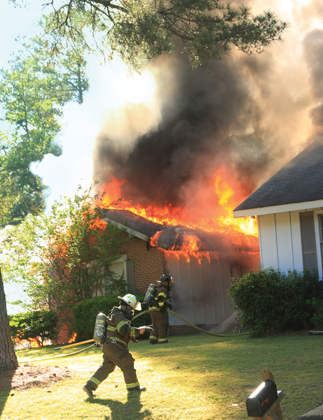Discover the ways to fireproof a home
A house fire can engulf and destroy a home in a matter of minutes. Even with the fast-acting response of firefighters, a home that has caught fire may be irreparably damaged by flames, soot and water. Fire is no laughing matter, and it behooves homeowners to take precautions to fireproof their homes as much as possible.The Centers for Disease Control and Prevention state that although death and injuries caused by residential fires have declined gradually during the past several decades, fire-related deaths continue to pose a significant health hazard. In 2010, it is estimated that someone died in a fire every 169 minutes in the United States alone. A person was injured by fire every 30 minutes, according to the National Fire Protection Association, Fire Analysis and Research Division. The Canadian Association of Fire Chiefs estimates an average of 375 people die every year from fires in Canada, mostly from smoke inhalation.
Most fires are largely preventable. The following are a few fireproofing measures for safety-conscious homeowners.
* Install smoke detectors and check the batteries regularly. Smoke inhalation causes many fire-related deaths. A smoke detector should be installed outside of every bedroom and on every level of the house. Don't install a smoke detector near a window, door or forced-air register, where drafts could interfere with the detector's operation. Be sure to routinely check that every smoke detector is working properly.
* Have a fire extinguisher in an easily accessible location. Ideally, there should be a fire extinguisher in every room of the home, but at the least keep one wherever fire is used regularly, such as a kitchen or by a fireplace. Ensure the fire extinguisher is charged and that you understand how to operate it.
* Remove combustible materials from around the house. Do not allow old clothing, rags, newspapers, or cardboard boxes to accumulate around the house. Discard newspapers and magazines as quickly as possible and be careful to avoid storing anything too close to heaters, furnaces or electrical equipment.
* Adhere to the recommended wattage in lamps and lighting fixtures. Do not exceed the recommended bulb wattage for lights around the house. There may be overheating or shorting that can lead to fire.
* Look for fireproof interior decor items. Nowadays, carpeting and furniture can be coated with fireproof chemicals. The added investment may be worth it in the long run.
* Do not leave candles unattended. Many people like the look and aroma that candles provide. Candles also provide emergency illumination in the event of a power outage. Candles can be easily knocked over and start a fire. In fact, candles are one of the top causes of house fires. Never leave a candle unattended, even for a short amount of time. And certainly never go to sleep without extinguishing a candle.
* Keep the chimney clean. Inspect the chimney flue regularly and have it cleaned to prevent an abundance of residual burnt material from accumulating. This creosote can catch fire itself.
* Use a fire-resistant roofing material. A roof should be made from metal, clay or asphalt tiles. Trim any overhanging branches or vegetation to reduce the amount of combustible material nearby.
* Have a fire-safe wall behind wood heaters. A brick wall or another fireproof material should be used on any walls that house a wood- or gas-burning appliance for added safety.
* Verify electrical safety. Extension cords and power strips should be kept to a minimum, and the outlets should not be overloaded. Replace fuses properly and don't be afraid to call a certified electrician to verify you are correctly set up.
By making a few tweaks in and around the house, a homeowner can decrease the likelihood of a fire.




